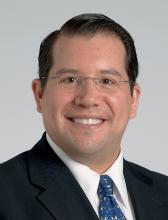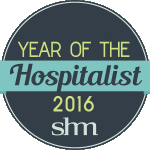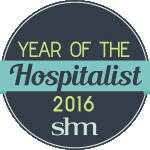User login
Editor’s note: As SHM celebrates the “Year of the Hospitalist,” we’re putting the spotlight on some of our most active members who are making substantial contributions to hospital medicine. Log on to www.hospitalmedicine.org/yoth for more information on how you can join the yearlong celebration and help SHM improve the care of hospitalized patients.
This month, The Hospitalist spotlights Moises Auron, MD, SFHM, a dual internal medicine/pediatrics hospitalist at the Cleveland Clinic. He is board certified in internal medicine and pediatrics and serves as associate professor of medicine and pediatrics at the Cleveland Clinic Lerner College of Medicine of Case Western Reserve University.
Question: What inspired you to begin working in hospital medicine and later join SHM?
Answer: I joined SHM as a third-year med-peds resident, influenced by my mentor and teacher, Dr. James C. Pile. I completed my medicine and perioperative consult rotation with him, and it was the first time in ages that anybody had served as such a motivating role model. He gave me a collection of The Hospitalist newsmagazines focused on perioperative medicine as well as a pack of articles around pertinent subjects for an internal medicine consultation service. It was a breath of fresh air; I found an entirely new niche in medicine. And in addition, he demonstrated to me how being a hospitalist was a fundamental pillar of patient care within the healthcare system. He showed me the elements of a thorough and pertinent system-based practice.
I met SHM CEO Dr. Larry Wellikson and the SHM team during a meeting in Philadelphia about 10 years ago and became even more acquainted with the society and its goals. I became a member on the spot. As a resident, I loved receiving both The Hospitalist and the Journal of Hospital Medicine. Both helped me also in my initial job search during my senior year of residency as well as with familiarizing myself with the latest hospital medicine literature. In short, being a member of SHM helped me cement my professional career path to hospital medicine.
Q: How has SHM provided you with resources to improve patient care and further your career?
I had the privilege of attending the Academic Hospitalist Academy and the Quality and Safety Educators Academy as well; both have helped me foster further goals in my career as well as achieve substantial professional and personal satisfaction.
The most important aspect of my membership has been becoming acquainted with a tremendous group of talented human beings, including both the SHM staff as well as hospitalist colleagues. The strength of SHM is its people: passionate providers and administrators who aim to make a better world for patients and doctors.
Q: What is your proudest moment working in hospital medicine?
A: Every single day of my job. As an academic hospitalist and a quality officer at my institution, I take tremendous pride in my job. I define ourselves as the super-internists; we are a quaternary medical center that cares for patients referred from all over the nation, and we need to elucidate obscure diagnoses and aim to offer a treatment and hope.
To me, what is more important is when I witness my residents being actively mindful about preventing harm: when they hardwire best practices such as good hand hygiene, precautions for prevention of falls, risk mitigation associated with any medical intervention … The list goes on. When I appreciate that behavior that becomes my proudest moment because I know that they will ensure the best outcomes for our patients and that I have made an impact.
Q: What do you see as the biggest opportunity for hospitalists as healthcare continues to evolve, and how can hospitalists rise to the challenge?
A: As the saying goes, “One of the tests of leadership is the ability to recognize a problem before it becomes an emergency.” We need to anticipate the way American healthcare is being delivered. The business model is changing, and the payment system is transitioning. Quality is being leveraged as a tool to decrease costs of care.
Hospitalists need to be creative in capitalizing on each individual patient encounter to maximize communication with other members of the healthcare team and use the patient’s hospitalization time strategically. We need to be the savings experts. We can recognize areas where unnecessary expenditure is used by having a lean mind and focusing on removing waste that will not impact our patients. We are the experts on the front line—we need to share the feedback to the leadership.
Q: What advice would you give to future providers considering a career in hospital medicine?
A: Become an SHM member early in your residency, aim to present a poster, participate at an SHM meeting, and engage in the networking process. SHM offers educational initiatives (e.g., Leadership Academy, Academic Hospitalist Academy, Quality and Safety Educators Academy), quality improvement programs (e.g., BOOST and Glycemic Control), and educational content to ensure your success in the Focused Practice in Hospital Medicine exam via the SHM SPARK tool.
Why so early? Because all of these resources help to build a sense of purpose and help to answer the question, “Where do I want to be five years from now?” Networking is fundamental, especially as it gives the opportunity to develop potential mentorship relationships and create teams for future collaboration endeavors.
Editor’s note: As SHM celebrates the “Year of the Hospitalist,” we’re putting the spotlight on some of our most active members who are making substantial contributions to hospital medicine. Log on to www.hospitalmedicine.org/yoth for more information on how you can join the yearlong celebration and help SHM improve the care of hospitalized patients.
This month, The Hospitalist spotlights Moises Auron, MD, SFHM, a dual internal medicine/pediatrics hospitalist at the Cleveland Clinic. He is board certified in internal medicine and pediatrics and serves as associate professor of medicine and pediatrics at the Cleveland Clinic Lerner College of Medicine of Case Western Reserve University.
Question: What inspired you to begin working in hospital medicine and later join SHM?
Answer: I joined SHM as a third-year med-peds resident, influenced by my mentor and teacher, Dr. James C. Pile. I completed my medicine and perioperative consult rotation with him, and it was the first time in ages that anybody had served as such a motivating role model. He gave me a collection of The Hospitalist newsmagazines focused on perioperative medicine as well as a pack of articles around pertinent subjects for an internal medicine consultation service. It was a breath of fresh air; I found an entirely new niche in medicine. And in addition, he demonstrated to me how being a hospitalist was a fundamental pillar of patient care within the healthcare system. He showed me the elements of a thorough and pertinent system-based practice.
I met SHM CEO Dr. Larry Wellikson and the SHM team during a meeting in Philadelphia about 10 years ago and became even more acquainted with the society and its goals. I became a member on the spot. As a resident, I loved receiving both The Hospitalist and the Journal of Hospital Medicine. Both helped me also in my initial job search during my senior year of residency as well as with familiarizing myself with the latest hospital medicine literature. In short, being a member of SHM helped me cement my professional career path to hospital medicine.
Q: How has SHM provided you with resources to improve patient care and further your career?
I had the privilege of attending the Academic Hospitalist Academy and the Quality and Safety Educators Academy as well; both have helped me foster further goals in my career as well as achieve substantial professional and personal satisfaction.
The most important aspect of my membership has been becoming acquainted with a tremendous group of talented human beings, including both the SHM staff as well as hospitalist colleagues. The strength of SHM is its people: passionate providers and administrators who aim to make a better world for patients and doctors.
Q: What is your proudest moment working in hospital medicine?
A: Every single day of my job. As an academic hospitalist and a quality officer at my institution, I take tremendous pride in my job. I define ourselves as the super-internists; we are a quaternary medical center that cares for patients referred from all over the nation, and we need to elucidate obscure diagnoses and aim to offer a treatment and hope.
To me, what is more important is when I witness my residents being actively mindful about preventing harm: when they hardwire best practices such as good hand hygiene, precautions for prevention of falls, risk mitigation associated with any medical intervention … The list goes on. When I appreciate that behavior that becomes my proudest moment because I know that they will ensure the best outcomes for our patients and that I have made an impact.
Q: What do you see as the biggest opportunity for hospitalists as healthcare continues to evolve, and how can hospitalists rise to the challenge?
A: As the saying goes, “One of the tests of leadership is the ability to recognize a problem before it becomes an emergency.” We need to anticipate the way American healthcare is being delivered. The business model is changing, and the payment system is transitioning. Quality is being leveraged as a tool to decrease costs of care.
Hospitalists need to be creative in capitalizing on each individual patient encounter to maximize communication with other members of the healthcare team and use the patient’s hospitalization time strategically. We need to be the savings experts. We can recognize areas where unnecessary expenditure is used by having a lean mind and focusing on removing waste that will not impact our patients. We are the experts on the front line—we need to share the feedback to the leadership.
Q: What advice would you give to future providers considering a career in hospital medicine?
A: Become an SHM member early in your residency, aim to present a poster, participate at an SHM meeting, and engage in the networking process. SHM offers educational initiatives (e.g., Leadership Academy, Academic Hospitalist Academy, Quality and Safety Educators Academy), quality improvement programs (e.g., BOOST and Glycemic Control), and educational content to ensure your success in the Focused Practice in Hospital Medicine exam via the SHM SPARK tool.
Why so early? Because all of these resources help to build a sense of purpose and help to answer the question, “Where do I want to be five years from now?” Networking is fundamental, especially as it gives the opportunity to develop potential mentorship relationships and create teams for future collaboration endeavors.
Editor’s note: As SHM celebrates the “Year of the Hospitalist,” we’re putting the spotlight on some of our most active members who are making substantial contributions to hospital medicine. Log on to www.hospitalmedicine.org/yoth for more information on how you can join the yearlong celebration and help SHM improve the care of hospitalized patients.
This month, The Hospitalist spotlights Moises Auron, MD, SFHM, a dual internal medicine/pediatrics hospitalist at the Cleveland Clinic. He is board certified in internal medicine and pediatrics and serves as associate professor of medicine and pediatrics at the Cleveland Clinic Lerner College of Medicine of Case Western Reserve University.
Question: What inspired you to begin working in hospital medicine and later join SHM?
Answer: I joined SHM as a third-year med-peds resident, influenced by my mentor and teacher, Dr. James C. Pile. I completed my medicine and perioperative consult rotation with him, and it was the first time in ages that anybody had served as such a motivating role model. He gave me a collection of The Hospitalist newsmagazines focused on perioperative medicine as well as a pack of articles around pertinent subjects for an internal medicine consultation service. It was a breath of fresh air; I found an entirely new niche in medicine. And in addition, he demonstrated to me how being a hospitalist was a fundamental pillar of patient care within the healthcare system. He showed me the elements of a thorough and pertinent system-based practice.
I met SHM CEO Dr. Larry Wellikson and the SHM team during a meeting in Philadelphia about 10 years ago and became even more acquainted with the society and its goals. I became a member on the spot. As a resident, I loved receiving both The Hospitalist and the Journal of Hospital Medicine. Both helped me also in my initial job search during my senior year of residency as well as with familiarizing myself with the latest hospital medicine literature. In short, being a member of SHM helped me cement my professional career path to hospital medicine.
Q: How has SHM provided you with resources to improve patient care and further your career?
I had the privilege of attending the Academic Hospitalist Academy and the Quality and Safety Educators Academy as well; both have helped me foster further goals in my career as well as achieve substantial professional and personal satisfaction.
The most important aspect of my membership has been becoming acquainted with a tremendous group of talented human beings, including both the SHM staff as well as hospitalist colleagues. The strength of SHM is its people: passionate providers and administrators who aim to make a better world for patients and doctors.
Q: What is your proudest moment working in hospital medicine?
A: Every single day of my job. As an academic hospitalist and a quality officer at my institution, I take tremendous pride in my job. I define ourselves as the super-internists; we are a quaternary medical center that cares for patients referred from all over the nation, and we need to elucidate obscure diagnoses and aim to offer a treatment and hope.
To me, what is more important is when I witness my residents being actively mindful about preventing harm: when they hardwire best practices such as good hand hygiene, precautions for prevention of falls, risk mitigation associated with any medical intervention … The list goes on. When I appreciate that behavior that becomes my proudest moment because I know that they will ensure the best outcomes for our patients and that I have made an impact.
Q: What do you see as the biggest opportunity for hospitalists as healthcare continues to evolve, and how can hospitalists rise to the challenge?
A: As the saying goes, “One of the tests of leadership is the ability to recognize a problem before it becomes an emergency.” We need to anticipate the way American healthcare is being delivered. The business model is changing, and the payment system is transitioning. Quality is being leveraged as a tool to decrease costs of care.
Hospitalists need to be creative in capitalizing on each individual patient encounter to maximize communication with other members of the healthcare team and use the patient’s hospitalization time strategically. We need to be the savings experts. We can recognize areas where unnecessary expenditure is used by having a lean mind and focusing on removing waste that will not impact our patients. We are the experts on the front line—we need to share the feedback to the leadership.
Q: What advice would you give to future providers considering a career in hospital medicine?
A: Become an SHM member early in your residency, aim to present a poster, participate at an SHM meeting, and engage in the networking process. SHM offers educational initiatives (e.g., Leadership Academy, Academic Hospitalist Academy, Quality and Safety Educators Academy), quality improvement programs (e.g., BOOST and Glycemic Control), and educational content to ensure your success in the Focused Practice in Hospital Medicine exam via the SHM SPARK tool.
Why so early? Because all of these resources help to build a sense of purpose and help to answer the question, “Where do I want to be five years from now?” Networking is fundamental, especially as it gives the opportunity to develop potential mentorship relationships and create teams for future collaboration endeavors.


